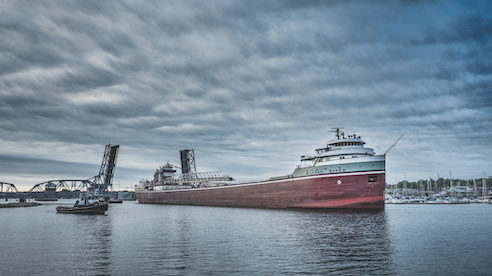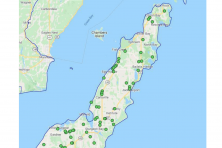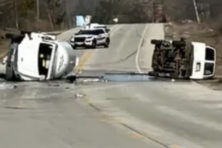In the Wake of the Baltimore Ship-Bridge Collision, a Local Captain’s Perspective
- Share
- Tweet
- Pin
- Share

Editor’s note: The Singapore-flagged, 948-foot container ship, the Dali, crashed into a 1.6-mile bridge in Baltimore, Maryland on March 26, at 1:28 am, causing a portion of the Francis Scott Key, four-lane suspension bridge to collapse. People plunged into the Patapsco River below.. A construction crew was fixing potholes on the bridge and eight people fell 185 feet into the 47-degree-F water. Two people were rescued – one unharmed, one critically injured – two bodies were recovered and four people remained missing. The cause of the collision, still under investigation, is believed to be the ship losing propulsion.
With Door County’s three bridges spanning the canal, and Fincantieri Bay Shipbuilding hosting Great Lakes freighters, the collision cuts close to home.
Freelance writer John Mielke wrote a piece for us in the Winter 2023/24 issue of Door County Living magazine entitled, “Steering the Big Boats: Retired Captain Ray Sheldon on piloting boats into winter layup.” We asked him to reach out to the Captain for comment on what the options are when a ship loses power, as had been reported had happened, as of deadline, with the Dali
When large ocean-going or Great Lakes freighters lose power, Ray Sheldon, who served as captain of the Wilfred Sykes and Joseph L. Block for more than 30 years, said the choices may be limited. One option might be trying to safely ground the vessel to keep it from drifting. Another could be the anchor. While dropping an anchor might seem to be a rather simple solution, Sheldon said captains must be aware of what’s below the surface.
“There’s different things you can try,” Sheldon said. “It’s always thinking outside the box about what the surrounding area is like.”
Without knowing the exact circumstances, Sheldon said that other propulsion systems such as bow and stern thrusters – which may not have been in use – would take time to engage. Emergency generators on board would also take time to bring online and may not be designed to power engines and thrusters.
Thanks to the advent of computer simulators with a virtual pilot house and surrounding views of various ports, Great Lakes captains are able to learn correct procedures for emergency situations.
“What do you do? Who do you contact?” Sheldon said. “First of all, it’s always thinking of minimizing damage to the surrounding area and thinking about minimizing damage to the ship.”
All the while, Sheldon said captains must be aware that, “you are reacting to the boat, the boat is not reacting to you.”
Sheldon has heard of other Great Lakes freighters losing power “out in the lake and not near anything dangerous.” Strict maintenance, he said, is designed to prevent that from happening. Sheldon said that monitoring the ship’s performance is an ongoing priority.
“There is always somebody watching monitors for the engines and generators,” he said. “There is always an engineer on watch and the chief engineer is on call 24 hours a day, just like the captain is. And there is always shore-side support staff, such as a fleet engineer.”
In addition to day-to-day maintenance, every five years each Great Lakes freighter goes into dry dock for mechanical, structural and electrical inspection and updates.
“The boat is actually dry-docked in Sturgeon Bay,” Sheldon said. “They pull them in, put them on the blocks and go through everything. They get their stamp of approval.”Sheldon remembers one time where he was forced to reduce power. “The Joe Block has those twin engines,” he said, “I’ve had where one engine wasn’t playing nice with the other engine – they have a governor that controls them. So, I had to go down to one engine.”



